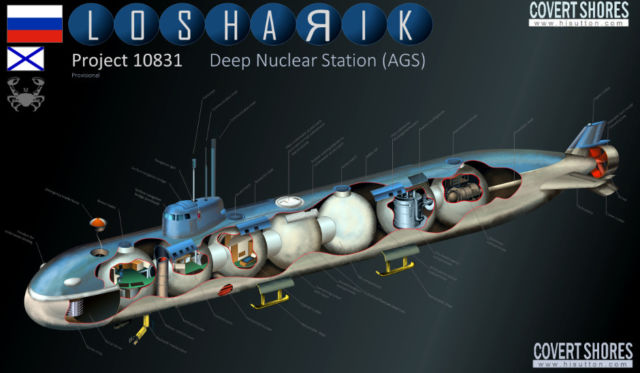On July 1, 14 Russian sailors—most of them senior officers with ranks equivalent to captain, commander, or lieutenant commander in the US Navy—died in an accident aboard a small nuclear-powered submarine designed for operations near or on the sea floor. The submarine Losharik (named after a Russian children's book character who is a horse made of juggling balls) was operating in the Barents Sea when the accident took place.
According to a Russian Navy statement published by TASS, the 14 "died in Russian territorial waters as a result of inhaling combustion products aboard a research submersible vehicle designated for studying the seafloor and the bottom of the World Ocean in the interests of the Russian Navy after a fire broke out during bathymetric measurements." The officers died while combating the fire.
In a statement delivered on July 3 from the Russian North Fleet's base in Severomorsk, Russian Defense Minister Sergei Shoigu said that three crew members and a civilian aboard the sub survived the disaster. The crew members who died, he said, "acted heroically in the critical situation. They evacuated a civilian expert from the compartment that was engulfed by fire and shut the door to prevent the fire from spreading further and fought for the ship's survival until the end."
The Kremlin has released a transcript of a meeting between Shoigu and Russian President Vladimir Putin. In it, Shoigu said that "we can repair the submersible quickly," thanks to actions by the crew to seal off the nuclear propulsion systems of the sub from the fire. "The crew has taken the necessary measures to save the unit, which is in working order." In other words, the actions of the officers who died fighting a fire from within a sealed compartment prevented an undersea nuclear disaster in the Arctic.
The accident is a public reminder of Russia's very secretive operations in the Arctic, which Putin's government has aggressively moved to protect militarily and exploit economically as the Arctic ice has retreated. Losharik has played a role in Russia's efforts to counter US submarines' covert incursions into their northern back yards. The vessel has put down sensors to detect subs—among other things.
Deep and dark

While the US Navy's "special purpose" submarine USS Jimmy Carter uses remotely operated vehicles to perform tasks at great depths, the Losharik is the product of a Soviet design effort focused on putting skilled people very close to the work. Officially designated as a "deep-diving nuclear-powered station," (атомная глубоководная станция), the AS-12 Losharik is not under command of the Russian Navy—it belongs to the Russian Main Directorate of Deep-Sea Research (GUGI), which is in turn a branch of Russia's Main Intelligence Directorate (GRU). It deploys from a "mothership" (a converted "Delta III" class ballistic missile submarine) and can perform "deep-sea research" missions on the sea floor—such as deploying sonar listening devices and underwater sonar beacons, as well as deploying or tapping into undersea cables.
First launched in August 1995, Losharik has played a role in Russia's efforts to further militarize the Arctic and assert Russia's economic claims to the Arctic seabed as well. The sub is known to have performed missions in 2012 on the sea floor of the Arctic Ocean at depths between 2,000 and 2,500 meters (6,600–8,200 ft), and some sources have claimed it can dive to 6,000 meters. By comparison, the US Navy's Los Angeles-class attack submarines have a test depth of 240 meters. The reason the sub can go so deep is also the source of Losharik's nickname: its inner pressure hull is essentially a chain of connected spheres within the sub's outer hull.
Unlike other submarines, the Losharik and other special operations subs operated under the auspices of GUGI are manned entirely by officers. But those who died aboard the Losharik were exceptionally senior, indicating that the "combat training task" the sub was involved in was likely an extremely sensitive mission or equipment test—one that called for a civilian industrial expert to be aboard. Half of the 14 officers killed held the rank of Captain 1st Rank (the equivalent of a US military O-6); two of them, including the sub's commander Alexander Oparin, had previously been named Heroes of the Russian Federation—the highest honorary title that can be bestowed upon Russian citizens, roughly equivalent to the US' Medal of Honor.
The crewmembers who died were:
- Captain First Rank Konstantin Ivanov
- Captain First Rank Andrey Voskresenskiy
- Captain First Rank Konstantin Somov
- Captain First Rank Denis Oparin
- Captain First Rank Vladimir Abankin
- Captain First Rank Denis Dolonskiy
- Captain First Rank Nikolay Filin
- Captain Second Rank Alexander Avdonin
- Captain Second Rank Dmitriy Solovyev
- Captain Second Rank Sergey Danilchenko
- Captain Third Rank Viktor Kuzmin
- Captain Third Rank Vladimir SukhinichevRead More – Source [contf] [contfnew]

Ars Technica
[contfnewc] [contfnewc]







